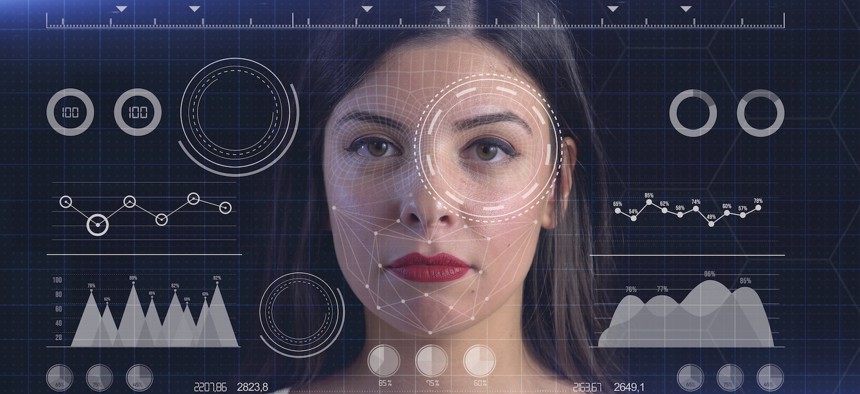
reklamlar/getty images
How TSA’s opt-outs for biometric screenings informed White House AI policy
The Office of Management and Budget’s recent guidance on the government’s responsible use of AI elevates TSA's practice of allowing travelers to decline biometric scans at airport security to national policy.
The Transportation Security Administration is on the front lines of White House efforts to deploy artificial intelligence in federal service delivery, and the way they're handling opt-outs from leery travelers is informing governmentwide efforts in AI deployment, officials said.
TSA's new generation of security screeners uses facial recognition technology to match photos of travelers against their government-issued photo IDs. An agency official previously told Nextgov/FCW that the agency “is currently in the beginning stages” of rolling out the new CAT-2 units with facial recognition capabilities to more than 400 airports in the coming years.
President Joe Biden's October 2023 executive order on the safe and secure development of AI mandated that the Office of Management and Budget also released guidance on the federal government’s use of AI. The White House said the new policy represents “a core component” of last year’s order and ensures that “travelers will continue to have the ability to opt out from the use of TSA facial recognition without any delay or losing their place in line.”
“We’ve already been doing this since day one of deploying these second generation CAT units — these CAT-2s with the camera — and we've already had these safeguards in place,” TSA spokesperson Alexa Lopez told Nextgov/FCW. “This policy, if anything, codifies that, while other agencies, they’re going to have to start doing this by a certain date.”
She said TSA has “been pushing signage” when it comes to airports using the CAT-2 units and has displayed information on relevant monitors noting that facial recognition screenings are optional at the more than 80 airports now using the screeners.
Additionally, Lopez said that TSA provided input into the OMB policy push, sharing examples of its approach to opt-out requests to "implement concrete safeguards when using AI in a way that will impact Americans' rights or safety."
Exciting times for AI at DHS
TSA’s Chief Technology, Data and AI Officer Matt Gilkeson — who’s been in government roles for almost 15 years — told Nextgov/FCW that this is “one of the most exciting times” to be a component agency of the Department of Homeland Security when it comes to the secure deployment of AI technologies.
“I've seen the entire apparatus of the department organized around this issue in a way that is enabling us to adopt the technology, explore it responsibly and look at what those use cases are,” Gilkeson said.
DHS launched a coordination group earlier this year for its sub-agencies to discuss AI issues, which served as a conduit for collaborating with OMB about the department’s needs and uses of AI. Gilkeson, who is also TSA's chief data officer and chief artificial intelligence officer, served as TSA’s representative on the group and worked with the agency’s various offices, including its legislative affairs and public affairs personnel, to provide feedback about the process.
“It was a really effective way to try that collaboration,” he said, adding that TSA was especially focused on ways “to move at speed and look at how we can kind of drive better adoption or faster adoption of some of these technologies while doing it in a responsible way.”
When TSA was created in 2001 following the September 11th terrorist attacks, Gilkeson said the agency's framework included ensuring its technology protected travelers’ civil rights, civil liberties, accessibility, equity and safety. Now, the agency is focused on ways of updating those tenets to account for AI’s growing use across the agency.
“You could take technology out and substitute it with AI and it applies,” he said.
Pushback from Congress
Some lawmakers and privacy advocates, however, have voiced concerns about TSA’s expanding use of facial recognition, including how the agency handles travelers’ biometric data and the clarity of its policy allowing individuals to opt-out of the facial recognition process.
A bipartisan group of senators, led by Sens. John Kennedy, R-La., and Jeff Merkley, D-Ore., introduced legislation in November 2023 that would require the agency to end its use of facial recognition “within three months” of the bill’s passage and would require it to receive congressional approval before deploying the technology in the future.
But Lopez said the agency doesn’t use the technology to replace human decisions or “use the biometrics captured at the checkpoint to create a machine learning loop to refine our matching algorithm.”
She also said that once travelers have gone through the facial recognition screening process, their photos are overwritten once the next passenger in line is scanned. Lopez said that TSA has worked to be as transparent as possible since day one about travelers’ ability to opt out of the facial recognition scan without any repercussions or losing their place in line.
“We are very clear that we don't use this for any kind of surveillance measures at all,” Lopez said, adding that increasing numbers of travelers at airports means “we have to look at something like biometric technology, which really helps with improving that security effectiveness and efficiency piece.”
.







